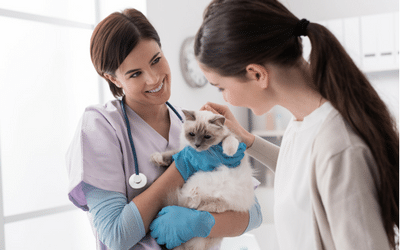Annual check-ups with the dentist, doctor, and optometrist are the norm for many of us.
These visits allow your health care provider to check on your health and identify any issues that may impact your long-term well-being.
The same applies to your cat. Taking your cat to the see the veterinarian once a year, rather than only when they are sick, is a step in the right direction for preventive care.
Because cats are masters at hiding illnesses, routine physical exams can identify signs of disease before it becomes severe.
It is important to remember that cats age significantly faster than humans. Cats reach the “human age” of 15 by the end of their first year and about 24, by the end of their second year.
With each calendar year after, a cat ages about 4 years. That makes a 5-year-old cat about 36 in human years. Think of your own health – a lot can happen in four years and if your cat is seeing the veterinarian only every 2 or 3 years, this translates into 8 to 12 “cat years”.
Seeing a veterinarian every year is critical in helping find early signs of disease. Prevention and early treatment is often less costly than waiting until your cat has a full-blown illness.
Some common conditions that veterinarians may identify in cats are:
- obesity
- cystitis (inflammation of the bladder)
- fleas
- dental disease
- heart murmur
- feline upper respiratory infection
At a yearly visit, any concerns or behavior changes (eating patterns, weight gain/loss, activity level, other behaviors) that you may have noticed with your cat can be discussed and addressed with your veterinarian.
Remember that all of these subtle changes may help your veterinarian uncover hidden issues that may not be posing problems now, but can become an issue down the road.
Making the time to take your cat to the veterinarian every year is just as important as scheduling your own health check-ups.
Many people avoid taking their cat to the veterinarian because it is stressful (for both the cat and the owner!). Taking a few steps prior to visiting the veterinarian may reduce the stress your cat experiences.
Leave the cat carrier out as an alternative sleeping spot and make it as comfy as possible with familiar smelling blankets. If your cat only goes in the car to see the vet, consider going on random car rides with your cat to reduce the association of the car with the veterinary clinic.
Be an advocate for your cat’s health and well-being. It’s a great time to make an appointment with your veterinarian for a check-up! Routine medical care can prevent illnesses and can detect diseases early, while they are easiest to treat.
Take advantage of the exceptional veterinary care available and bring your cat to the vet!
LifeLearn News
Note: This article, written by LifeLearn Animal Health (LifeLearn Inc.) is licensed to this practice for the personal use of our clients. Any copying, printing or further distribution is prohibited without the express written permission of Lifelearn. Please note that the news information presented here is NOT a substitute for a proper consultation and/or clinical examination of your pet by a veterinarian.













